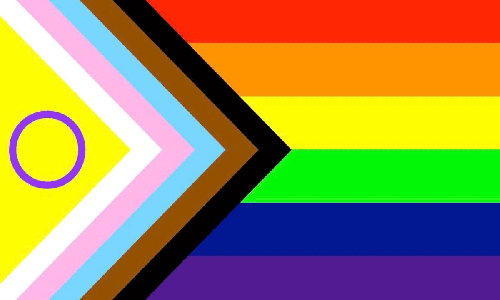




Phobias are irrational fears
PlayLGBTQPhobias are irrational fears
 LGBTQPHOBIAS
LGBTQPHOBIAS
 acephobia
acephobia
 arophobia
arophobia
 biphobia
biphobia
 enbyphobia
enbyphobia
 gayphobia
gayphobia
 homophobia
homophobia
 interphobia
interphobia
 lesbophobia
lesbophobia
 polyphobia
polyphobia
 serophobia
serophobia
 transphobia
transphobia
The term LGBTQphobia is applied to phobias and other forms of rejection toward LGBTQ+ people. They consist of all negative attitudes, actions and words toward sexual and gender diversity. It can be defined as the irrational fear of LGBTQ+ people or those perceived to be LGBTQ+, which can also lead to contempt, disgust and hate.
Based on a report from a study that was conducted by ILGA World and Stonewall’s International Work in 2020,
one quarter of the world’s population views LGBTQ+ people as criminals.
The irrational fear of people on the asexuality spectrum or those perceived as such can also lead to contempt, disgust and hate.
Asexual people can suffer several forms of violence, including the invalidation of their sexual identity. Asexual
people are often judged for their lack of libido and sometimes their loved ones and even their health care
professionals try to “correct” their level of sexual attraction.
45% of asexual people indicated that people had tried to cure them or had given suggestions on how to cure
them.
1
“You can’t not feel sexual attraction, all humans do; if you don’t have it, it’s because you have a trauma or
a hormone problem. You should see a doctor.”
The irrational fear of people on the aromantic spectrum or those perceived as such can also lead to contempt, disgust and hate.
This phobia can be manifested in a variety of ways in the everyday lives of aromantic people, including negative attitudes, discrimination, violence, harassment and invalidation.
The irrational fear of bisexual people or those perceived as such can also lead to contempt, disgust and hate. It is often caused by prejudices such as the idea that bisexual individuals are more sexually active than the average person, that they are more unfaithful, that they don’t know what they want or that their identity is just a phase.
57.7% of bi men have experienced verbal harassment in the workplace
1
46% of bisexual women have been raped.
2
“I couldn’t date a bisexual; I’d be too afraid he’d cheat on me.”
“He’s clearly a repressed gay man.”
2 NISVS: An overview of 2010 findings on victimization by sexual orientation (2010) National Center for Injury Prevention and Control.
The irrational fear of non-binary people or those perceived as such can also lead to contempt, disgust and hate. It is based on the belief that gender binary is natural and undeniable.
Nearly 1 in 5 non-binary people reported that they experienced bullying at school in 2021. 1 “There’s no such thing as non-binary. You’re either a guy or a girl.”
Irrational fear specifically directed toward gay men or those perceived to be gay can also lead to contempt, disgust and hatred. This fear is often based on the misconception that gay men are feminine and therefore inferior (misogyny), or that these types of relationships are unnatural. When talking about the fear and rejection of feminine gay men, the word “sissyphobia” is sometimes used.
This phobia can be manifested in a variety of ways in the everyday lives of homosexual men, including negative attitudes, discrimination, violence, harassment, invalidation and even death. “I don’t want to go to a gay bar, I’d be too afraid the gays would be all over me.”
The irrational fear of homosexual people or those perceived as such can also lead to contempt, disgust and hate. It is often related to misconceptions and certain religious beliefs.
More than 50% of countries around the world still criminalize homosexuality. “A family is a mom and a dad; anything else is unnatural and bad for the child.”
The irrational fear of intersex people can also lead to contempt, disgust and hate. Intersex variation is a medical diagnosis that indicates that a person’s sex characteristics don’t conform to medical and social expectations for the appearance of a female or male body. These variations may be reflected in primary (genitalia) or secondary (skeleton, body hair, fat and muscle distribution, etc.) sexual characteristics that are influenced by chromosomes and hormones. About 1.7% of the world’s population is born with intersex characteristics.
Since 2015,
more than 1,385 surgeries
have been performed on children under the age of 14 who had a variation in sexual development; 838 of those
surgeries were performed on children under the age of two. (Source : la Régie de l’assurance maladie du Québec
1
)
69 %
of intersex people surveyed reported that they had experienced some form of discrimination in 2021.
2
. (According to the Center for American Progress)
3 out of 5 intersex people
stated that they avoid medical appointments because of fear of prejudice.
"There are only two sexes: XX or XY!”
2 https://www.them.us/story/69-percent-intersex-people-experienced-discrimination-2021-report
The irrational fear of lesbian women or those perceived as such can also lead to contempt, disgust and hate. Lesbophobia is found at the intersection of sexism and homophobia.
This phobia can be manifested in a variety of ways in the everyday lives of lesbian women, including harassment,
assault and invalidation.
15% of lesbians in Canada experienced physical violence based on their sexual orientation between 2015 and 2020
and 12% experienced sexual violence.
“You two are really hot together, can I join you?”
The phobia of people who are polyamourous (practice ethical non-monogamy) or are perceived as such. Polyamourous people have multiple partners and practice non-monogamy in an ethical and consensual manner. Polyamory is not part of the LGBTQ+ acronym, but polyphobia often appears in forms of LGBTQphobias.
Much in the same way as LGBTQphobias, polyphobia can be found in laws (such as legal recognition of polyamorous
families and protection from discrimination) and in social interactions. For example, on the television show
Touche Pas à Mon Poste that aired in January 2019, a participant stated, “Love between three people doesn’t exist,
it was invented by ... it was clearly created by nutcases. Love is one person, we love one person, and for me
those people have a problem in their brain. (…) it’s disgusting and that’s all.”
1
Polyphobia also appears in homophobic discourses, especially when the question of marriage is brought up,
particularly by threatening that if we legalize marriage between two men or two women, we will have to legalize
polygamy.
Being HIV positive is not part of the LGBTQ+ acronym, but serophobia often appears in forms of LGBTQphobias. HIV-positive people are people living with HIV; because this disease is not well understood, they can be victims of rejection and of various types of violence. In addition, homosexual or bisexual men are often lumped together with HIV-positive people, which means that homophobia and serophobia are often connected. Some people even go so far as to say that HIV is a divine punishment, a consequence of homosexuality, which is considered to be against nature. 1
1 in 5 people living with HIV in Canada
are denied health care services due to stigma and discrimination.
2 “Being gay is unhealthy; the proof is that they all have AIDS!”
Available resources include: RÉZO, Quebec AIDS Foundation, Portail VIH/SIDA du Québec
2 https://pivot.quebec/2022/12/01/vih-sida-la-lutte-contre-la-stigmatisation-est-loin-detre-terminee/
The irrational fear of trans people and people who don’t conform in terms of gender identity or expression, or who are perceived as such, can also lead to contempt, disgust and hatred. Transphobia is especially fuelled by the portrayal of trans women as “men dressed up as women" and the classification (until recently) of trans identity as a mental illness.
327 trans people were murdered in 2022
95%
of them were women
1
“It’s dangerous to let trans women go into women’s locker rooms.”
Irrational fears, real consequences
Learn more: it’s the rational thing to do
We’ve prepared all the information you need to learn about it! Let’s move toward a more inclusive future together and deconstruct our irrational fears.
